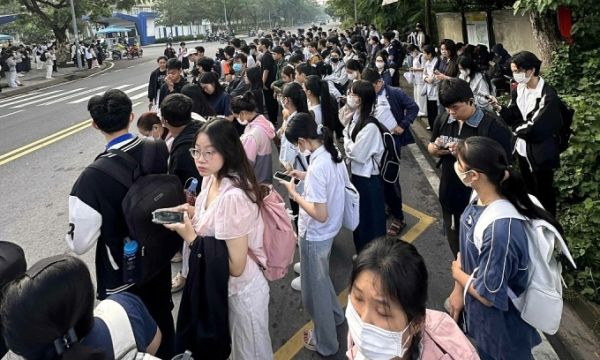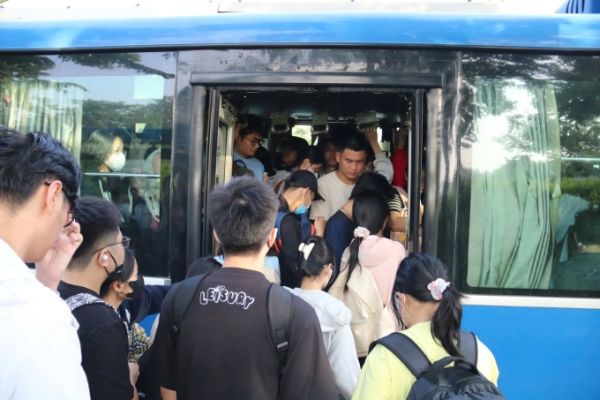
Phuong, a second-year student at the University of Social Sciences and Humanities, lives in Zone B of the Vietnam National University HCMC dormitory complex.
While in her freshman year she would leave her dorm at 6:30 a.m., take bus No. 33 to Zone A four kilometers away and walk a kilometer to class.
|
Students wait for buses at Vietnam National University HCMC’s Zone B dormitory at 6 a.m. on Sept. 10, 2025. Photo by Read/Kim Thanh |
But since mid-August this year she has had to wake up an hour earlier and wait from 5:30 a.m. alongside hundreds of other students for bus No. 53 or 99.
The problem started when bus No. 33, which runs between An Suong Bus Station and the university, cut its route to end at Zone A instead of Zone B.
Phuong says: “When 33 stopped going to Zone B, everyone switched to 53 or 99. These buses were already full, and now with even more passengers, it takes forever to get on,”
Many students find the four-kilometer walk between the two zones exhausting and so pay VND20,000-30,000 (US$0.80-1.20) for a ride-hailing motorbike though getting one during rush hour can be difficult and a bus ticket costs only VND3,000 ($0.12).
“I have been late to class three times and lost attendance points in the past two weeks,” Phuong says.
The Vietnam National University HCMC dormitory complex is the country’s largest, with 47 buildings across 42 hectares. Rooms cost VND230,000-1.9 million ($9-76) per month.
Zone B houses more than 25,000 students from different schools within the university. Most travel to class by bus, the dorm management center says.
Students whose schools are inside the complex take a bus from Zone B to Zone A, then walk about one kilometer to class. Those at the University of Technology and Education or University of Technology take another bus for five to seven kilometers.
In the past, students at Nong Lam University and University of Economics and Law could take bus No. 33 from Zone B all the way to their schools.
The dorm management said cutting bus No. 33’s route has caused major commuting difficulties.
 |
|
Students gather at Zone B of the Vietnam National University HCMC dormitory to catch buses at 6 a.m. on Sept. 10, 2025. Photo by Read/Nhu Ngoc |
Thanh Tuan and Ngoc Thanh, students at the University of Technology and Education, said buses No. 53 and 99 are always packed tight with passengers.
“I usually have to wait nearly an hour for four or five buses before I can get on,” Tuan says. “Sometimes I have to walk from Zone B to Zone A to catch another bus.”
Phuong Nhung, a second-year student at Nong Lam University, said her school is less than five kilometers away but now she must take two buses and wait much longer.
“Sometimes I have to wait one to two hours for a bus,” she says. “It is tolerable in the morning, but in the afternoon heat, I am usually drenched in sweat and exhausted before class even begins.”
 |
|
A student from the Vietnam National University HCMC’s Zone B dormitory takes a ride-hailing motorbike to class on Sept. 10, 2025 after buses failed to arrive. Photo by Read/Nhu Ngoc |
HCMC’s Public Transport Management Center says it has noted the overcrowding at the bus stop in Zone B after bus No. 33 was re-routed on Aug. 1 as part of a public transport network reorganization.
“The main demand from Zone B students is to travel by bus to Zone A and then walk to their classes within the university complex.”
To ease congestion, it has temporarily added bus No. 8 to reduce pressure on buses No. 53 and 99, especially in the morning and midday.
It is also considering a direct bus route from Zone B to schools across the complex. A proposal is expected to be completed next week and submitted for approval.